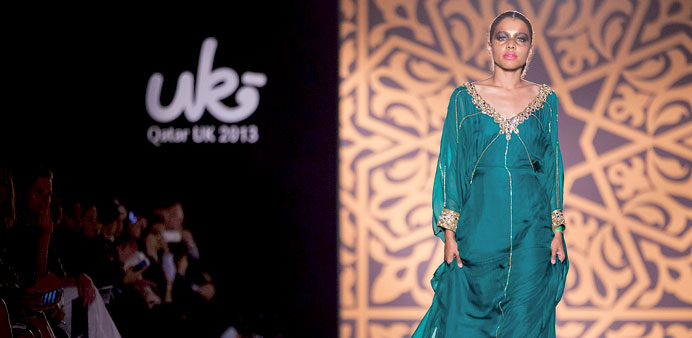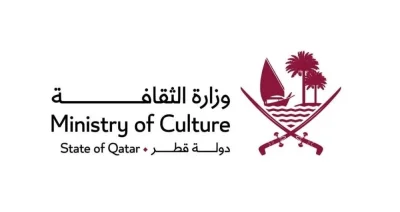Held at London’s Victoria and Albert Museum, the fashion show was a spectacle as graceful models glided past in their flowing abayas and colourful jalabiyas, creating an aura of mystery and enchantment.
By Denise Marray
In the magnificent setting of London’s Victoria and Albert Museum, over-looked by Raphael masterpieces, the fashion worlds of east and west merged in a stunning display of elegance, craftsmanship and innovation.
‘Fashion Exchange – The September Show’, part of Qatar UK 2013 Year of Culture, attracted a full-house to revel in the designs of three Qatari designers, Elham al-Ansari, Fathiya Ahmad al-Jaber and Hessa Abdulla al-Mannai, paired with the fantastical headwear of renowned milliner, Philip Treacy and the gorgeous jewellery and handbags of Asprey.
This was a bold concept conceived to showcase in a novel way the best of British and Qatari design. It was intended to be a spectacle to stir the imagination; as the graceful models glided past in their flowing abayas and colourful jalabiyas they created an aura of mystery and enchantment.
Fashion Exchange was developed by businesswoman and former model Farheen Allsopp and Sheikha Raya al-Khalifa, a writer and contributor to Style.Com Arabia. “The whole point of the Qatar UK Year of Culture is to look at diverse cultures and how we can collaborate,” said Allsopp, who looked amazing in her evening gown.
She added that the concept of the fashion show should be viewed in this context: “It’s not really about whether abayas should be worn with hats – it’s about two very different styles coming together and using a platform to collaborate.”
The elegant Sheikha Raya al-Khalifa, who favours simple abayas accessorised with jewellery, said: “Women are eager to express themselves through their abayas and that is why we are here today – to present to the west and challenge misconceptions that the abaya is something of an oppressive garment. In fact it is a cultural representation of our modern and modest adaptation of how we adhere to Islam.”
Sheikha Raya feels that the abaya can be enjoyed by women without so much attention being paid to the exclusiveness of the label or brand often associated with western designs. “I think we are given a bit more freedom because it levels out the playing field which goes back to our notion in Islam that we are all equal. Whether you pay hundreds for a designer abaya or just a bit – they are all beautiful,” she said.
Speaking of the idea to incorporate the headwear of Philip Treacy, who designed hats for 36 guests at the wedding of Prince William and the Duchess of Cambridge, Sheikha Raya said: “Farheen and I thought he was a perfect match. When we went to his studio we immediately saw pieces that were really relevant and looked a bit like Shaylas.”
She emphasised that the aim was to “create a dialogue and exchange ideas” over the long term. She explained that mentorships are being set up for Qatari fashion students in London and that connections are being established to build on the work already undertaken. She noted that the fall/winter collections have pieces inspired by the abaya and hopes the garment, like the sari and kimono, will be a global design influence.
Designer Fathiya Ahmad al-Jaber said her key fashion inspiration is her mother and she also admired the work of Chanel, Valentino and Alexander McQueen. “My dream is to be a famous designer and I want to show how Gulf women are developing their sense of fashion,” she said. Al-Jaber studied Business and Economics Accounting at Qatar University and now works at the Qatar Foundation.
She explained that while she has been designing for 10 years, it was only three years ago that she turned what had been a private hobby within the home into a business. She participated in one of the Roudha Center’s exhibitions which gave her the confidence and practical information to set up her own venture. She designs for women of all ages from 15 to 70.
Ed Vaizey, UK Minister for Culture, Communications and Creative Industries, speaking at the press conference preceding the show said: “You often don’t hear the voices of the women who are wearing these particular dresses; so when they say, ‘actually the abaya is very comfortable and convenient and we love it and it is a cultural symbol of which we are proud’, these are great messages to hear.”
He described the Qatar UK 2013 Year of Culture as being a great success to date and said that during his visit to Doha he had received a very warm welcome. “It was fantastic to see a government that takes culture so seriously and understands how important culture is along with education to help transform a nation,” he said. He paid special tribute to the leading roles in promoting culture played by Sheikha Moza and Sheikha Mayassa.
Graham Sheffield, Director of Arts for the British Council and Chair of the Qatar UK 2013 Year of Culture Steering Committee, said: “I think the benefits of the Year of Culture will continue to roll out over the next five to 10 years. There is an awareness that the two countries have the potential to have a much more profound relationship through the medium of arts, science, sport and education.”
Asked if he was a ‘fashion aficionado’ he laughingly pointed out that he had made an effort to look his best. “Sitting here wearing my Kenzo suit and my Zegna shirt – I am trying not to be too much of a slouch,” he said.
Shareefa Fadhel, Managing Director and Co-founder of the Roudha Center, a one-stop shop supporting female entrepreneurs, said she would like to see more opportunities opening up for Qatari women in the fashion industry. While currently there aren’t enough jobs to absorb the young fashion designers emerging from the universities, she sees positive developments which bode well for the future.
“Things are moving fast; you’ve got the Qatar Luxury Group opening which will be looking for aspiring designers as well as many up-and-coming small fashion houses and Fashion Week – so there’s a lot of movement,” she commented. She expects to see a strong focus in the coming years on the role of women in terms of equality, economic development and leadership. At the end of the show, former British ambassador to Qatar, Michael O’Neill paid tribute to the organisers of the event which he described as “a fantastic show in an amazing location which raised understanding of cultures.”
VIP guests attending the show included: Mohamed al-Ka’abi, Cultural Attache, Embassy of the State of Qatar, who attended with his son and daughters (al-Ka’abi, sits on the Qatar UK 2013 Steering Committee); Rashid Alduhaimi, 1st Secretary, Embassy of Qatar; Mooza Saif al-Mansouri, wife of the Qatari ambassador; members of the al-Thani family; members of the al-Khalifa ruling family of Bahrain; Tamara Ralph from Ralph and Russo Designs and Cherie Blair.
Giving her reaction to the event, Sheikha Noora al-Thani said: “It was a great show that showcased our culture and the traditional clothes we wear. I want to design my own abayas.”
* The Year of Culture is a programme of cultural exchanges and events in Qatar and the UK co-ordinated by the Qatar Museums Authority and the British Council with the support of the respective Ministries of Culture and Foreign Affairs and a number of leading Qatari and British cultural and educational organisations. HH the Emir Sheikh Tamin bin Hamad al-Thani and His Royal Highness the Prince of Wales are Patrons of Qatar UK 2013.



